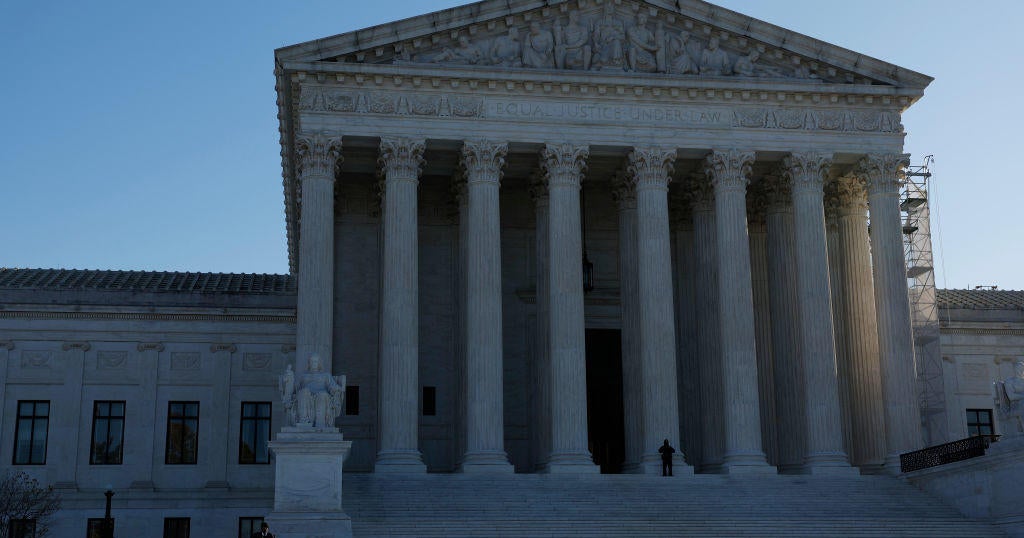CBS News
Here’s how many Category 5 hurricanes have hit mainland U.S.

The Atlantic hurricane season begins on June 1 and runs through Nov. 30. Hurricanes are rated on the Saffir-Simpson Hurricane Wind Scale, which includes five categories based on the storm’s sustained wind speeds. It also estimates possible damage to property, ranging from “some damage” to “catastrophic.”
The highest is Category 5, which is marked by a storm that has sustained wind speed of 158 mph or higher for at least one minute.
According to the National Hurricane Center, there have been an estimated 42 tropical cyclones that have reached Category 5 status in the Atlantic Basin since 1924, the most recent being Hurricane Milton, which is churning toward Florida’s Gulf Coast as a powerful storm.
This number is likely higher because satellite monitoring technology was not available until the 1960s and cyclones that could have been a Category 5 storm may have remained undetected.
Several recorded Category 5 hurricanes reached that intensity multiple times during their lifetime. Hurricanes Allen (1980), Isabel (2003) and Ivan (2004) each soared to Category 5 intensity three separate times in their journeys.
Meanwhile, the November 1932 Cuba hurricane and Hurricane Irma in 2007 spent the longest combined time at Category 5 strength at 78 and 77 hours, respectively, according to the National Oceanic and Atmospheric Administration’s database.
While multiple hurricanes that made landfall in the U.S. peaked at Category 5, only four storms on record have done so at that intensity.
1935 Labor Day Hurricane
The Great Labor Day Hurricane road through Florida in early September 1935 becoming what the hurricane center says is the most intense storm ever to make landfall in the U.S.
It caused the deaths of 408 people – most of them World War I veterans working in the Florida Keys where the storm made its first landfall.
According to NOAA, the storm caused damages estimated at $6 million ($137 million in 2024).
Hurricane Camille in 1969
Bettmann via Getty
The most intense storm of the 1969 Atlantic hurricane season, Camille slammed into Mississippi just before midnight on Aug. 17. The hurricane produced a peak storm surge of 24 feet and flattened nearly everything along the Mississippi coast.
It caused an estimated $1.42 billion in damages (more than $12 billion in 2024) and killed more than 259 people.
Hurricane Andrew in 1992
On Aug. 22, 1992, Hurricane Andrew pummeled southern Florida as a monster Category 5 storm with sustained wind speeds as high as 165 mph and gusts as high as 174 mph.
Steve Starr/CORBIS/Corbis via Getty Images
It caused $30 billion in damage and more than 40 deaths. It was the costliest natural disaster in the history of the U.S. at the time.
When the 1992 hurricane season ended, the name Andrew was removed from the list of future names for Atlantic tropical cyclones.
Hurricane Michael in 2018
Hurricane Michael barreled into Mexico Beach, Florida, on Oct. 10 with peak winds of 160 mph – making it the strongest storm on record to make landfall in the Florida Panhandle. It was the first Category 5 storm to make landfall on mainland U.S. since Andrew 26 years earlier.
Scott Olson / Getty Images
The cyclone was initially measured as a Category 4 storm, but forecasters upgraded it in April 2019 after conducting a detailed post-storm analysis.
At least 74 deaths were attributed to the storm – including 59 in the U.S. and 15 in Central America.
Michael caused an estimated $25.1 billion in damages.
Historic Category 5 storms
Here are the names of the estimated 42 tropical cyclones that have reached Category 5 intensity since 1924:
“Cuba” – 1924
“San Felipe II Okeechobee” – 1928
“Bahamas” – 1932
“Cuba” – 1932
“Cuba-Brownsville” – 1933
“Tampico” – 1933
“Labor Day” – 1935
“New England” – 1938
“Great Atlantic” – 1944
Carol – 1953
Janet – 1955
Esther – 1961
Hattie – 1961
Inez – 1966
Beulah – 1967
Camille – 1969
Edith – 1971
Anita – 1977
David – 1979
Allen – 1980
Gilbert – 1988
Hugo – 1989
Andrew – 1992
Mitch – 1998
Isabel – 2003
Ivan – 2004
Emily – 2005
Katrina – 2005
Rita – 2005
Wilma – 2005
Dean – 2007
Felix – 2007
Matthew – 2016
Irma – 2017
Maria – 2017
Michael – 2018
Dorian – 2019
Lorenzo – 2019
Ian – 2022
Lee – 2023
Beryl – 2024
Milton – 2024
CBS News
What to know about the charges in UnitedHealthcare CEO’s killing

Watch CBS News
Be the first to know
Get browser notifications for breaking news, live events, and exclusive reporting.
CBS News
Prominent pro-Putin ballet star Sergei Polunin says he’s leaving Russia

Moscow — Former Royal Ballet star Sergei Polunin, famous for his tattoos of Russian President Vladimir Putin, on Wednesday announced that he plans to leave Russia. The Ukrainian-Russian dancer was one of the most prominent stars who backed Russia’s unilateral 2014 annexation of Crimea and its military assault on Ukraine. He was rewarded with prestigious state posts.
In a rambling, misspelled message on his Instagram account, Polunin wrote: “My time in Russia ran out a long time ago, it seems at this moment that I have fulfilled my mission here.”
The post first appeared Sunday on his little-read Telegram account.
Ian Gavan/Getty
Polunin, 35, did not give a specific reason for leaving but said that “a time comes when the soul feels it is not where it should be.”
He said he was leaving with his family — his wife Yelena and three children — but “where we will go is not clear so far.”
In the summer, the dancer complained of a lack of security and said he was being followed.
Polunin, who was born in Ukraine, backed Putin’s 2014 annexation of Crimea — a prelude to the ongoing, full-scale invasion of Ukraine that Putin launched in February 2022.
The dancer was granted Russian citizenship in 2019. He was appointed acting head of a dance academy in occupied Crimea’s biggest city, Sevastopol, and director of the city’s opera and ballet theatre, for which a large new building is under construction.
Just last year he was decorated by Putin for his role in popularizing dance. But in August he was replaced as head of the dance academy by former Bolshoi prima Maria Alexandrova, and a week ago, Russia’s arts minister Olga Lyubimova announced his theater director job would go to singer Ildar Abdrazakov.
This came after on December 9 Polunin published a social media post saying he was “very sorry for people” living in the heavily bombarded village near Ukraine’s city of Kherson, where his family originates from, and that “the worst deal would be better than war.”
Ian Gavan/Getty
Aged 13, Polunin won a scholarship to train at the Royal Ballet School in London and became its youngest ever principal dancer.
With his tattoos — including a large depiction of Putin’s face emblazoned prominently on his chest — and his rebellious attitude, he became known as the “bad boy of ballet” and caused a sensation by resigning from the Royal Ballet at the height of his fame in 2012.
Later he made a 2015 hit video to Irish musician Hozier’s song “Take Me to Church” and was the star of a 2016 documentary called “Dancer.”
He moved to perform at Moscow’s Stanislavsky Musical Theatre’s ballet before launching a solo career, starring in dance performances in roles including the mystic Grigory Rasputin.
In 2019 he posed for AFP with a large tattoo of Putin on his chest which he later supplemented with two Putin faces on either shoulder. He also has a large Ukrainian trident on his right hand.
This year he took part in Putin’s campaign for reelection as a celebrity backer.
CBS News
Supreme Court takes up South Carolina’s effort to defund Planned Parenthood

Washington — The Supreme Court on Wednesday agreed to consider South Carolina health department’s effort to cut off funding from Planned Parenthood because it performs abortions, wading into another dispute over access to the procedure in the wake of its reversal of Roe v. Wade.
The case, known as Kerr v. Edwards, stems from the state’s decision in 2018 to end Planned Parenthood South Atlantic’s participation in its Medicaid program. Gov. Henry McMaster, a Republican, directed the South Carolina Department of Health and Human Services to deem abortion clinics unqualified to provide family planning services and end their Medicaid agreements.
Planned Parenthood operates two facilities in the state, one in Charleston and the other in Columbia, and provides hundreds of Medicaid patients with services like physicals, cancer and other health screenings, pregnancy testing and contraception. Federal law prohibits Medicaid from paying for abortions except in cases of rape or incest, or to save the life of the mother.
Planned Parenthood and one of its patients, Julie Edwards, sued the state, arguing that cutting off its funding violated a provision of the Medicaid Act that gives beneficiaries the right to choose their provider.
A federal district court blocked South Carolina from ending Planned Parenthood’s participation in its Medicaid program, and a U.S. appeals court upheld that decision, finding that Edwards could sue the state to enforce the Medicaid Act’s free-choice-of-provider requirement.
The legal battle has already been before the Supreme Court in the past, with the high court last year ordering additional proceedings after deciding in a separate case that nursing home residents could sue their state-owned health care facility over alleged violations of civil rights.
After reconsidering its earlier decision, the three-judge appeals court panel ruled unanimously in March that Edwards’ lawsuit against the state could go forward and said South Carolina couldn’t strip Planned Parenthood of state Medicaid funds.
“This case is, and always has been, about whether Congress conferred an individually enforceable right for Medicaid beneficiaries to freely choose their healthcare provider. Preserving access to Planned Parenthood and other providers means preserving an affordable choice and quality care for an untold number of mothers and infants in South Carolina,” Judge Harvie Wilkinson wrote for the 4th Circuit panel.
South Carolina officials asked the Supreme Court to review that decision, marking the third time the case has been before the justices. The justices agreed to take up the question of whether “the Medicaid Act’s any-qualified provider provision unambiguously confers a private right upon a Medicaid beneficiary to choose a specific provider.”
South Carolina is among the more than two dozen that have passed laws restricting access to abortion in the wake of the Supreme Court’s June 2022 decision reversing Roe v. Wade. In South Carolina, abortion is outlawed after six weeks of pregnancy with some exceptions.
Several states have also enacted laws blocking Planned Parenthood from receiving Medicaid funding, including Arkansas, Missouri, Mississippi and Texas.













